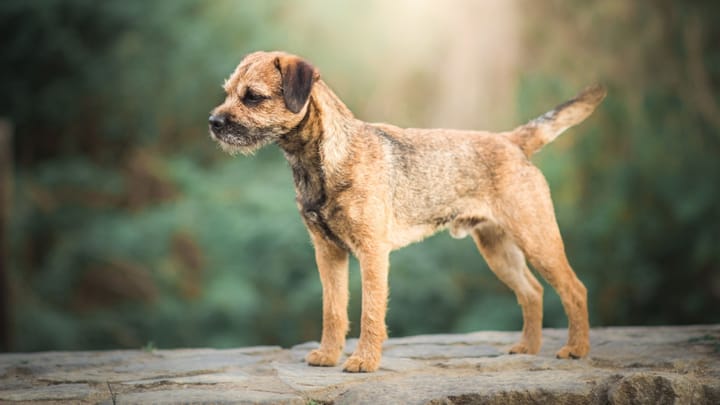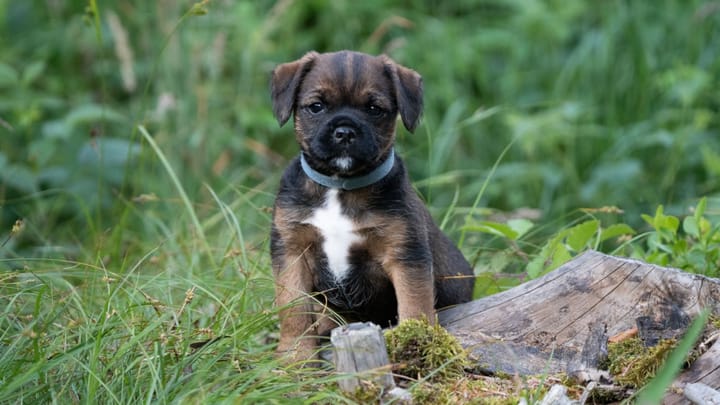Border Terrier


This is a work dog exclusively, very brave and strong-headed. Following a certain popular fad for the breed, the Border Terrier Clubs have fought to keep this dog’s hunting traits intact- he remains, as a result, a hunter. He is, however, very affectionate towards his owners and family. His biggest vice is that he gets into frequent fights with dogs of the same sex. He is not suitable for small children as he does not tolerate being treated like a ‘teddy bear’, and can react in unpredictable ways.
|
Life expectancy |
The Border Terrier has a life expectancy of between 12 and 14 years |
|
Temperament |
|
|
Size |
Small
|
|
Adult size |
Female
Between 13 and 14 in
Male
Between 14 and 16 in
|
|
Adult weight |
Female
Between 11 and 13 lb
Male
Between 11 and 15 lb
|
|
Coat colour
The coat can be red, wheaten, grey and tan or blue and tan. |
Red Sand Blue |
|
Type of coat
The coat is medium-long. The coat is dense and coarse to the touch, the undercoat is close. |
Long |
|
Eye colour
The eyes are dark, with a very lively expression. |
Brown
|
|
Purchase price |
The Border Terrier costs between £530 and £720 |
The border terrier is one of the most popular dog breed in the UK. They were once called Coquetdale or Redescale Terriers and we mainly used to hunt foxes.
More details about the Border Terrier
Border Terrier: Origins and history
Originally hailing from the south of Scotland, from the Borders region which is his namesake, he is reportedly the result of a cross between an ancient version of the Bedlington, the Lakeland Terrier, and the Dandie Dinmont Terrier. The breed was only officially recognised by the English Kennel Club in 1920, but is actually much older than that: it springs from a group of Terriers dubbed ‘working Terriers’. The Border Terrier took part in agricultural trade shows at the beginning of the 19th century, in the Borders county between Scotland and England.
Physical characteristics of the Border Terrier
The Border Terrier is a very ‘original’ dog, on account of the shape of his head: strong and short, resembling that of an otter. The body, on the other hand, is rather slender and light. The skull is moderately large, the muzzle short and robust. The eyes are small and lively, exuding a very intense expression. The ears are small, v-shaped, and folded over, close to the cheeks. The limbs are straight, and have a rather dainty bone structure. The tail is moderately short, set high and sported cheerfully, but it should never curve upwards over the back.
FCI classification of the Border Terrier
-
Group 3 - Terriers
-
Section 1 : Large and medium sized Terriers
Border Terrier: Characteristics
Border Terrier: Behaviour
Training a Border Terrier
The Border Terrier is a work dog, he does therefore absorb rather rapidly what is asked of him and takes great pleasure in interacting with his master if the latter is respectful, coherent and both firm and gentle at the same time.
Some basic discipline must be acquired from the pup’s youngest age in order to stop bad habits from developing. In fact, even if he is generally good-natured, his character remains rather strong, and without a strict framework, this dog could rapidly gain the upper hand and do as he pleases.
Border Terrier: Lifestyle
Breed compatibility Border Terrier
Border Terrier: Purchase price
The price of a Border Terrier varies depending on its origins, age, and gender. You have to count an average of £720 for dogs registered at the Kennel Club.
With regards to the monthly budget required to meet the needs of a dog of this size, you have to estimate an average of £20 per month.
Border Terrier: Shedding
Light
The Border Terrier is lucky enough to experience very little hair loss, even during moulting seasons, which go practically unnoticed with him.
Border Terrier: Grooming
The maintenance of this little hunting dog is not at all complicated, a few brushes a week will be enough to maintain the beauty and protective properties of his coat.
However, it will be necessary to take the dog to a professional for hair removal a few times a year. This is because the Border Terrier hardly experiences any hair loss or moulting seasons, he therefore needs to be ‘aided’ in the elimination of dead hairs.
Other than that, his ears need to be checked and cleaned regularly.
Border Terrier: Health
The average life expectancy is estimated at 13 years.
Rustic and quite robust despite his delicate appearance, this dog also enjoys a long life, generally over 15 years.
Very enduring and passionate when at work, this hunting dog can overcome the heat but it is nevertheless unreasonable to have him be very active during intense heat.
His double coat allows him to tolerate challenging weather without a problem, be it the cold of rain, since he is equipped with a dense coat and a close undercoat.
The large stores of energy this dog possesses leave no room for excess weight.
The Border Terrier is lucky enough to enjoy an impeccable health, his iron constitution and quality breeding have therefore shielded him from all hereditary disease.







